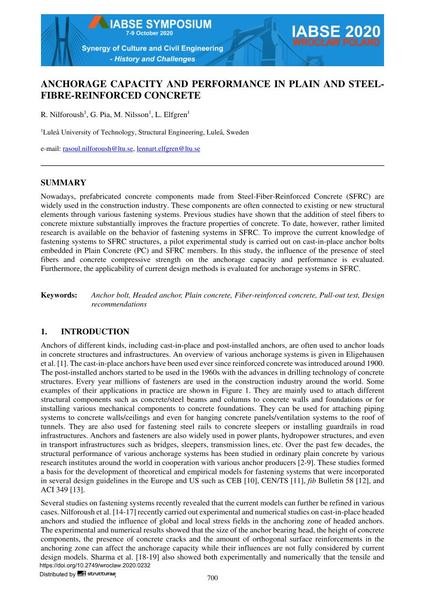Anchorage Capacity and Performance in Plain and Steel-Fibre-Reinforced Concrete

|
|
|||||||||||
Détails bibliographiques
| Auteur(s): |
R. Nilforoush
(Luleå University of Technology, Structural Engineering, Luleå, Sweden)
G. Pia (Luleå University of Technology, Structural Engineering, Luleå, Sweden) M. Nilsson (Luleå University of Technology, Structural Engineering, Luleå, Sweden) L. Elfgren (Luleå University of Technology, Structural Engineering, Luleå, Sweden) |
||||
|---|---|---|---|---|---|
| Médium: | papier de conférence | ||||
| Langue(s): | anglais | ||||
| Conférence: | IABSE Symposium: Synergy of Culture and Civil Engineering – History and Challenges, Wrocław, Poland, 7-9 October 2020 | ||||
| Publié dans: | IABSE Symposium Wroclaw 2020 | ||||
|
|||||
| Page(s): | 700-709 | ||||
| Nombre total de pages (du PDF): | 10 | ||||
| Année: | 2020 | ||||
| DOI: | 10.2749/wroclaw.2020.0232 | ||||
| Abstrait: |
Nowadays, prefabricated concrete components made from Steel-Fiber-Reinforced Concrete (SFRC) are widely used in the construction industry. These components are often connected to existing or new structural elements through various fastening systems. Previous studies have shown that the addition of steel fibers to concrete mixture substantially improves the fracture properties of concrete. To date, however, rather limited research is available on the behavior of fastening systems in SFRC. To improve the current knowledge of fastening systems to SFRC structures, a pilot experimental study is carried out on cast-in-place anchor bolts embedded in Plain Concrete (PC) and SFRC members. In this study, the influence of the presence of steel fibers and concrete compressive strength on the anchorage capacity and performance is evaluated. Furthermore, the applicability of current design methods is evaluated for anchorage systems in SFRC. |
||||
